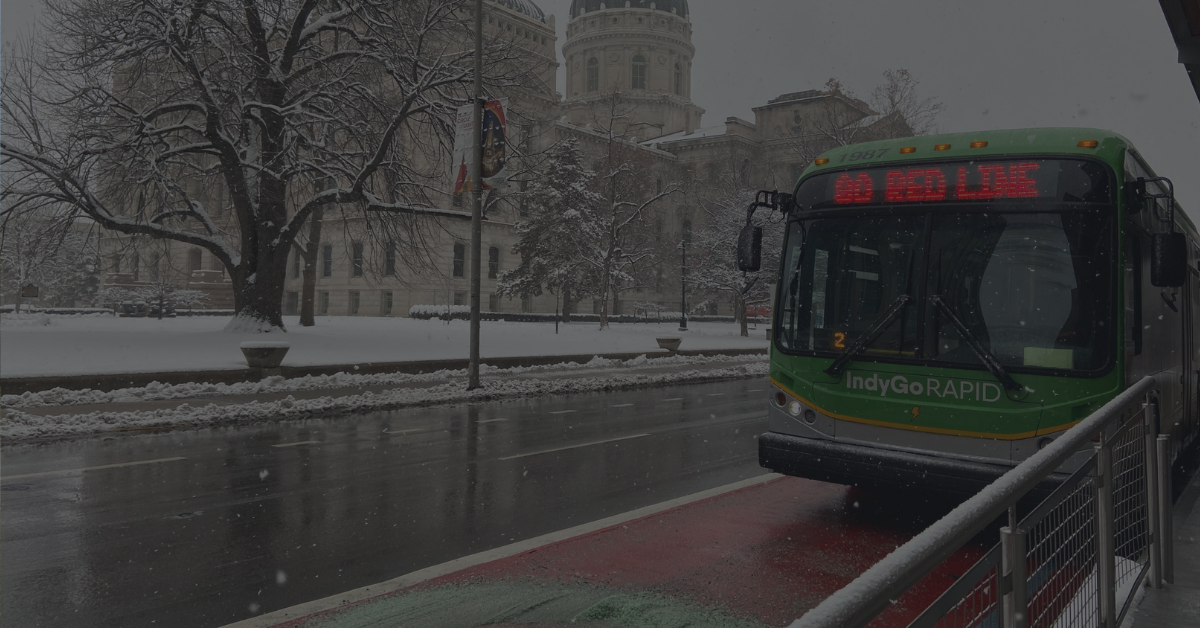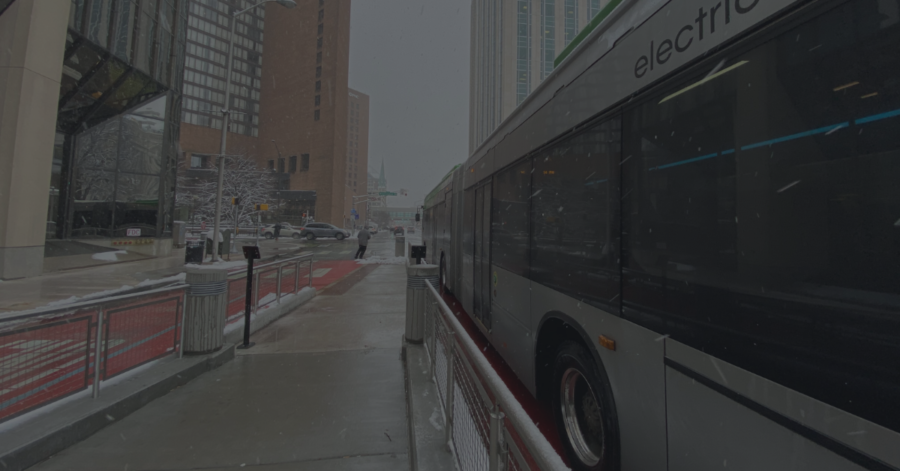
Winter Weather
Let your IndyGo driver get you to your destination safely! Icy roads, heavy snowfall and high winds all affect travel conditions. During these times, passengers are highly encouraged to allow for extra travel time to and from each destination.
IndyGo anticipates maintaining normal service on local and rapid service. However, riders should be aware that incompetent weather may cause some delays system-wide depending on road conditions and to use caution during commutes. The agency always encourages riders to plan ahead and take precautions when traveling during the cold weather months.
Tips for traveling in winter weather:
- Wear warm, highly visible clothing, so you can be spotted at a bus stop.
- Layer clothing to ensure warmth and wear a coat, hat, gloves and scarf to reduce exposure to cold temperatures.
- Allow for extra travel time to and from your destination. Plan for delays due to bad road conditions.
- Be extra careful and watch your step. Snow and ice can make sidewalks, steps and bus floors slippery. Hold onto the railing when boarding and exiting the bus.
- Buses may experience travel difficulties getting to residential areas and side streets. If you’re traveling from these places, you may need to use a different stop. Riders can plan their trips using Google Maps, the Transit app or by visiting our website at https://www.indygo.net/plan-your-trip/.
- Detours and route delays can also be found on the IndyGo Rider Alerts Twitter page here. Real-time alerts are available when you text ##### (Five digit stop ID) to (463) 208-4344.
Extreme Heat
Summertime in Indianapolis can bring high heat indexes, which can be dangerous for those who commute using public transportation due to frequently traveling outdoors. Examples of extreme heat exhaustion include headache, nausea, dizziness, tiredness, excessive sweating, dehydration and more. Severe dehydration alone can be life-threatening.
IndyGo puts safety at the forefront of its mission and always encourages riders to plan ahead and take precautions when traveling during hot weather months. To help lower the risk of injury to our riders, we gathered the list below to keep passengers prepared.
Tips for traveling in the heat:
- Plan ahead. When possible, perform your activities in the cooler parts of the day.
- Allow for extra travel time. A slower walk could mean less stress on your body, keeping you cooler. More time also grants the chance for taking frequent breaks when outdoors. Finally, leaving earlier could mean you have time to find a more shaded route to arrive at your bus stop.
- Stay hydrated. Bring water or sports drinks with you for your commute. Colder drinks are best. Avoid alcohol and caffeine, which speed up dehydration.
- Dress accordingly. Wear thinner, light colored and loose-fitted clothing to reduce sunlight/heat absorption and increase air circulation.
- Don’t forget to use sunscreen as well.
- Travel light. Carrying less weight means less body exertion. Only bring the necessary items if walking longer distances to bus stops.
- Bring a fan or umbrella. Fans can increase air flow and umbrellas provide shade.
Severe Thunderstorms
It’s not uncommon for severe storms to move across the area when hot weather occurs. When there’s a risk of thunderstorms, that include the potential for damaging winds and tornadoes, passengers are encouraged to take the following precautions if they must travel.
Tips for traveling during severe storms:
- Heavy rainfall can make riders difficult to see at bus stops. Consider wearing bright clothing and bringing a flashlight to notify the driver you’re waiting.
- In the event of a lightning storm, do your best to avoid metal, which conducts electricity, and tall objects.
- In the event a tornado occurs, head toward shelter immediately. If shelter is not available, find the lowest point of ground, lie down and cover your head with your arms or another object.
- Stay up to date regarding weather updates by watching the local news or listening to the radio.
- Plan for delays and allow extra travel time to and from your destination.
- Contact IndyGo’s Mobility Solutions Care Center at 317.635.3344 for real-time bus arrivals and information on detours. Expect longer wait times on the phone due to heavy call volumes that come with bad weather. Click here for Care Center hours.
Contact IndyGo’s Customer Care Center
When severe weather hits, riders can contact IndyGo’s Customer Care Center at 317.635.3344 for real-time bus arrivals and information on detours. Expect longer wait times on the phone due to heavy call volumes that come with bad weather.
Paratransit riders, if you have a ride scheduled for an evening there’s severe weather that you can re-schedule, we encourage you to do so by the Customer Care Center as well.

IndyGo News
IndyGo is committed to your safety during inclement weather. View our latest updates below.
Rapid Transit and Snow
In addition to ensuring a comfortable ride during colder months, this will also help maintain efficient service for the vehicles. IndyGo is committed to providing safe and efficient service on all our routes, including the Red Line.
All IndyGo rapid transit stations feature a snowmelt system in which will melt snow from stations. The Department of Public Works (DPW) salts and plows streets, including dedicated bus-only lanes.
In the event that the snowmelt system does not operate as it should, the IndyGo team will have contracted crews clear the areas. IndyGo is responsible for removing snow and salting IndyGo facilities and properties, including all IndyGo rapid transit stations.
